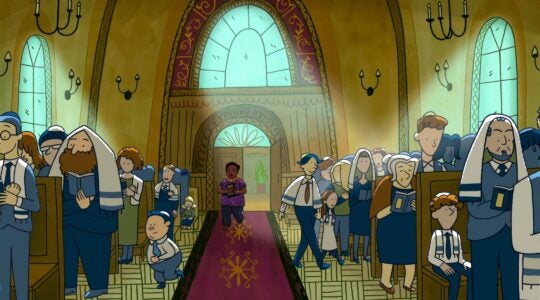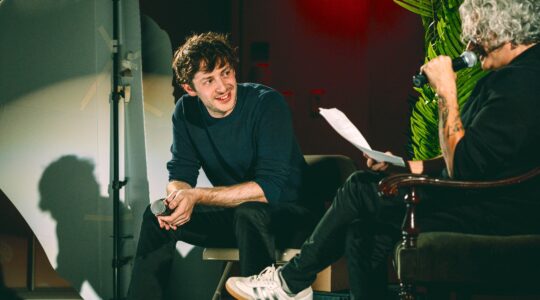Perhaps it’s no coincidence that Groundhog Day is soon upon us, because after reading recently of an “effort by an informal group of about two dozen concerned Jews … who believe the community is in crisis and doesn’t know it,” I looked at my calendar to confirm that it is indeed 2014, and not 2004 or 1994. I’m quite sure that in those years too, we would find the same article in the same newspaper, perhaps even by the same editor, as if trapped in a Bill Murrayesque reliving of the same day over and over again.
What’s changed? Almost everyone named as part of this group seeking to promote in-marriage — Bayme, Wertheimer, Cohen, Barack Fishman, Ukeles, Rosenblatt — has been in positions of Jewish communal leadership for decades, in most cases the exact same positions.
Which means that for decades, these folks have been at the helm of a ship that they’ve scraped against the iceberg of American society — trends of religious pluralism, increasing secularism, growing intermarriage, full acceptance of Jews and even philo-Semitism, all trends none of them have successfully countered in any measurable way, or even necessarily wanted to. And yet every few years, usually after another study shows just how many fellow passengers have fled their ship, they once again inform us of how to best rearrange the deck chairs.
And who’s to blame for this alleged communal crisis? Those actually steering the ship? Of course not. It’s all those damn passengers who fled.
Let’s be clear that this group does not seek to save “the Jews.” The Pew Research Center survey that sparked their new/old crisis found more Jews in America today than at any time in our history. No, it is a very specific kind of Jewish community they seek to rescue, the ethnic one you’re born into from two Ashkenazi parents, preferably in Brooklyn in the 1950s. Why can’t we have more Jews like that?
What seems to get lost in academic conversations about what Jews should or shouldn’t do is that admonitions are of little help in the lives of actual people. Eight years ago I shared a stage with Steve Bayme of the American Jewish Committee in a conversation about intermarriage and Jewish continuity moderated by Gary Rosenblatt of The Jewish Week. In his write-up of that event, Rosenblatt explained, “The most poignant aspect … was the tone of the questions from the large and attentive audience,” focused “less on the communal and sociological ramifications” than on seeking advice for real situations in their lives. “I realized that many were here for their own private reasons looking for answers it may have been impossible to give them.”
But those were not impossible answers to give them, and large segments of the organized Jewish community have actually been providing those answers for years. I’ve been honored to work on a wide variety of initiatives that engage people in organized Jewish life, in ways that directly address their interests and needs. For example, our Grandparents Circle, to help Jewish grandparents share their religious and cultural identity with grandchildren being raised in interfaith homes, has since spread to 125 communities across the U.S. and Canada and touched the lives of thousands of intermarried families.
The Grandparents Circle didn’t yet exist to be offered to the audience that night, but it does now. And we created it along with many other initiatives with only a fraction of the resources Steve Bayme’s organization has at its disposal. So in the ensuing eight years, what programs has he implemented to effect his vision of “asserting that endogamy was the clear goal of the Jewish community?”
The in-reach/outreach debate in the ’80s and ’90s encouraged some organizations and movements to accept and better serve intermarried households, but the larger investment went into programs that tacitly or explicitly promoted endogamy by encouraging young Jews to “do Jewish” with other Jews — the very goal Bayme, Wertheimer, etc. seem to spin as a new idea. Yet this approach had already been taken — on a massive scale. How did the two approaches work out?
The Pew survey found that 61 percent of intermarried households are raising their children with a Jewish identity, and more than half of all children of intermarriage under age 30 consider themselves Jewish. That’s a huge victory for inclusion. Detractors point to the lack of formal Jewish education or synagogue membership among the intermarried. But again I would ask, who’s still at the helm of those ships that you now expect the folks who were once shunned or priced out or found no meaning to re-board? The very insider-only gathering described by Rosenblatt [“We’re Losing The Continuity Battle. Who Cares?” Editor’s column, Jan. 24], to talk about the intermarried without actually involving them in the conversation, will confirm for many that not enough has changed.
Either way, the one thing the Pew study settled is that promoting endogamy failed. Despite all the rabbinic railing against intermarriage in the ’70s and ’80s, and all the “continuity” programs of the ’90s and ’00s, the intermarriage rate continued to increase. Today there are almost twice as many intermarried as in-married households, and more Americans under age 25 from intermarried than in-married households. This genie cannot be put back into the bottle.
While there is no certainty what new models will emerge, inclusion and engagement are the buzzword across the landscape. Now a group of long-timers who’ve been wrong in their approach for decades are doubling-down rather than gracefully stepping aside for the next generation of leaders.
The continued fantasy on the part of these communal policy advisers that we can foster a rich and vibrant liberal Jewish community, while at the same time telling intermarried households that they or their parents did something wrong because they married who they loved, is a non-starter. It is as irresponsible an approach as if the National Weather Service made forecasts based on the actions of small furry rodents.
Paul Golin is associate executive director of Big Tent Judaism/Jewish Outreach Institute (www.JOI.org).
The New York Jewish Week brings you the stories behind the headlines, keeping you connected to Jewish life in New York. Help sustain the reporting you trust by donating today.




